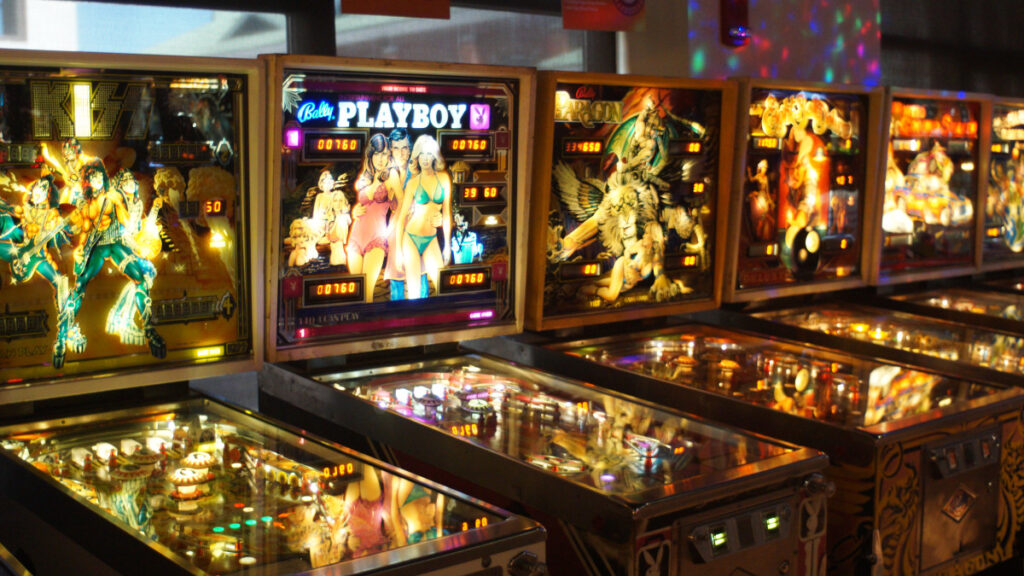Arcade games have become a cultural phenomenon, captivating players since their inception in the 1970s. These vibrant, interactive experiences not only entertain but also reflect technological advancements and shifts in gaming culture. From pixelated beginnings to immersive modern designs, the evolution of arcade games tells a fascinating story of innovation and creativity.
As we dive deeper, we will explore their various genres, iconic titles, and how these games shaped social interactions and youth culture, particularly during the 1980s and 1990s. The genres themselves, ranging from platformers to shooters, highlight the diversity in gameplay and artistic expression, while the nostalgia surrounding these games continues to fuel a resurgence in interest today.
History of Arcade Games

The history of arcade games is a fascinating journey that reflects the evolution of technology, entertainment, and social interaction over the decades. Originating in the early 1970s, arcade games transformed from simple mechanical devices into complex digital experiences enjoyed by millions around the world. This progression not only highlights the creativity inherent in game design but also illustrates the shifts in consumer preferences and technological advancements.
The first commercially successful arcade game, “Computer Space,” was released in 1971, marking the inception of the arcade gaming era. Its design paved the way for subsequent developments, notably the release of “Pong” in 1972, which established a gaming phenomenon and ignited the public’s interest in video games. The arcade industry began to flourish, leading to a golden age in the late 1970s and early 1980s, characterized by the introduction of iconic titles such as “Space Invaders,” “Pac-Man,” and “Donkey Kong.”
Key Milestones in Arcade Games Development
Several milestones have defined the trajectory of arcade games, each contributing to the richness of gaming culture. These pivotal moments include the following:
- 1971: “Computer Space” introduced the concept of arcade gaming, albeit with limited success.
- 1972: “Pong” became the first widespread arcade hit, establishing the gaming arcade as a social gathering place.
- 1978: “Space Invaders” revolutionized the gaming industry, introducing high scores and competitive play.
- 1980: “Pac-Man” transformed gaming into a cultural phenomenon, appealing to a broader demographic.
- 1981: “Donkey Kong” introduced the platform genre and marked the debut of one of gaming’s most recognizable characters, Mario.
- 1990s: The introduction of 3D graphics with titles like “Street Fighter II” and “Mortal Kombat” ushered in a new era of immersive gameplay.
- 2000s: The rise of the internet and online gaming changed the arcade landscape, leading to the decline of traditional arcade venues.
Impact of Technology Advancements on Arcade Game Design
Technological advancements have consistently shaped the design and gameplay of arcade games. The evolution from analog to digital technology has enabled developers to create more engaging and complex gaming experiences.
The shift from simple graphics to high-definition visuals transformed player immersion. Notable changes include:
- Graphics: Early arcade games featured pixelated, monochrome graphics, while modern games utilize 3D rendering, providing lifelike visuals.
- Sound: Advances in audio technology transformed sound effects and music, enhancing the overall atmosphere of games.
- Interactivity: Innovations such as touch screens and motion sensors have redefined player interactions, making games more dynamic.
- Network Connectivity: The integration of online features has allowed for multiplayer capabilities, competitions, and leaderboards, extending the arcade experience beyond physical venues.
“The evolution of arcade games exemplifies the intersection of technology and creativity, creating a lasting impact on entertainment culture.”
The journey of arcade games is an ongoing narrative, with future developments likely to continue the legacy of innovation and engagement, reflecting the technological trends of each new era.
Popular Arcade Game Genres

Arcade games have evolved significantly over the years, with various genres captivating players around the globe. These genres not only reflect different gameplay mechanics but also offer diverse experiences that cater to varied player preferences. From the fast-paced action of shooters to the strategic thinking required in puzzle games, each genre contributes uniquely to the arcade gaming landscape.
One of the most prominent features of arcade games is their varied genres, each providing distinct gameplay experiences. This diversity allows players to engage with games that match their skill levels and interests. Below are some of the most popular arcade game genres, along with iconic examples and a comparison of their gameplay mechanics.
Platformers
Platformers are characterized by their focus on jumping and navigating through levels filled with obstacles and enemies. The primary objective is often to reach the end of the level, collecting items and power-ups along the way.
- Super Mario Bros. – Released in 1985, this iconic game features Mario navigating through the Mushroom Kingdom to rescue Princess Peach. Its innovative level design set the standard for the platformer genre.
- Sonic the Hedgehog – Released in 1991, Sonic introduced speed-based gameplay, where players control a fast-moving blue hedgehog through vibrant worlds. This game emphasized momentum and quick reflexes.
- Donkey Kong – Launched in 1981, this classic platformer introduced players to Mario’s first adventure, where he must save a damsel in distress from the titular ape. It was one of the first games to feature a narrative structure.
Platformers typically involve precise jumping mechanics and level exploration, which can differ significantly from other genres. The focus on timing and spatial awareness is crucial, making these games both challenging and rewarding.
Shooters
Shooters involve players controlling a character or vehicle to eliminate enemies while dodging projectiles. This genre can be further divided into sub-genres, such as rail shooters and first-person shooters.
- Space Invaders – Released in 1978, it is one of the earliest shooting games where players control a ship firing at descending aliens. This game pioneered the shooter genre and introduced high-score competitions.
- Galaga – Launched in 1981, Galaga added depth with the ability to capture enemy ships, providing strategic gameplay elements that enhanced the classic shooter experience.
- Time Crisis – Introduced in 1995, it combined shooting with cover mechanics, allowing players to hide from enemy fire, changing how shooters were played in arcades.
The gameplay mechanics in shooters often emphasize reflexes and strategy, requiring players to make quick decisions while managing their resources, contrasting with platformers’ focus on movement and navigation.
Puzzle Games, Arcade games
Puzzle games challenge players to solve problems and complete tasks through logic and strategy. They often involve arranging pieces or matching colors to progress through levels.
- Tetris – Created in 1984, Tetris is a timeless classic that involves fitting falling blocks into lines. Its simple yet addictive mechanics have made it a staple in gaming history.
- Dr. Mario – Released in 1990, this game incorporates falling capsules that players must arrange to eliminate viruses, blending action and strategy in puzzle-solving.
- Puyo Puyo – First launched in 1991, it features colorful blobs that players must match to clear the screen, enhancing competitive play with multiplayer mechanics.
Puzzle games often require critical thinking and planning, setting them apart from platformers and shooters, which focus more on physical skills and reflexes. Each genre’s distinct approach to gameplay creates unique experiences that cater to a wide range of players.
The Cultural Impact of Arcade Games
Arcade games have left an indelible mark on youth culture and social interactions, particularly during the vibrant eras of the 1980s and 1990s. Initially, these games provided a social outlet where young people could gather, compete, and forge friendships, establishing a unique community centered around gaming. This phenomenon not only shaped their leisure activities but also influenced their identity and social dynamics.
Influence on Youth Culture and Social Interactions
Arcade games served as a gathering place for teenagers and young adults, fostering a sense of camaraderie. These arcade spaces became not just locations to play games, but community hubs where various social interactions flourished. Players often formed friendships over high scores and competition, creating a shared language and culture centered around gaming.
The vibrant atmosphere of arcades, with flashing lights and the sounds of beeping machines, contributed to the excitement of the gaming experience. The competitive nature of games like “Pac-Man,” “Street Fighter,” and “Donkey Kong” encouraged players to hone their skills and strive for the top score. This competition was not solely about individual achievement; it sparked friendly rivalries and social interactions that shaped a generation’s experience.
Additionally, arcade games were often featured in popular media during this period, solidifying their cultural significance. Movies like “The Wizard” showcased the competitive arcade scene, while songs often referenced gaming culture, embedding these experiences within the fabric of youth identity.
Role in Popular Media
Arcade games significantly permeated popular media, influencing films, television shows, and music. The portrayal of arcade culture in movies helped to elevate its status in society. For instance, films such as “Tron” and “WarGames” directly connected gaming with themes of adventure and technological prowess, captivating audiences and elevating the importance of the gamer archetype.
Television also captured this trend, with shows like “Saved by the Bell” frequently featuring characters hanging out at arcades. These portrayals normalized arcade gaming as a staple of youth entertainment, reinforcing the idea of arcades as essential social spaces.
In music, the sounds and themes of arcade games influenced a generation of artists who incorporated these elements into their work, leading to a crossover between gaming and music genres. The iconic 8-bit sounds became a nostalgic symbol, often referenced in songs and performances, bridging the gap between gaming and broader cultural expressions.
Resurgence and Nostalgia in Modern Times
In recent years, there has been a notable resurgence of interest in arcade gaming, largely driven by nostalgia for the simplicity and charm of classic games. This revival is evident in the emergence of retro arcades and gaming cafes that celebrate the past while catering to a new generation of gamers.
Modern gaming trends have rekindled interest in retro game design and aesthetics, leading to the development of new games that mimic the style and gameplay of classic arcade hits. The popularity of indie games that channel the spirit of 80s and 90s arcade games showcases the lasting influence these titles have had on game design.
Moreover, the rise of emulators and online platforms has made it easier for people to access and relive these classic experiences, fostering a community of enthusiasts who share their love for retro gaming. Events like arcade tournaments and gaming conventions further contribute to this resurgence, allowing fans to celebrate their shared interests in nostalgic gaming culture.
“Arcade gaming not only shaped a generation’s leisure activities but also influenced their identity and social dynamics.”
If you’re looking to enjoy the strategic gameplay of Clash of Clans on a bigger screen, you can easily find the clash of clans download pc options available online. This allows you to build your village and engage in epic battles with friends or players around the globe. Simply follow the instructions on the website to get started and enhance your gaming experience!
If you’re looking to enjoy the strategic depths of Clash of Clans on your computer, you’re in the right place. The process is straightforward when you check out how to clash of clans download pc. This will guide you through the steps to install the game on your PC, allowing you to build your village and compete with friends from the comfort of your desk.


